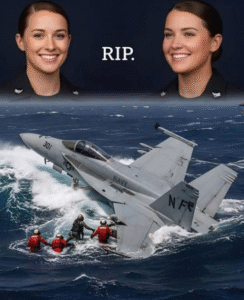RIP: Two Aviators from California Lost in a Fatal Fighter Jet Accident
The sky, once their canvas, became their grave.
On October 15, 2024, two trailblazing U.S. Navy aviators—Lt. Cmdr. Lyndsay P. Evans and Lt. Serena N. Wileman—were killed when their EA-18G Growler jet crashed during a routine training mission near Mount Rainier, Washington. Both women were 31 years old. Both were California natives. And both had recently returned from a combat deployment in the Red Sea, where they flew missions defending maritime vessels from Houthi drone attacks.
Their deaths sent ripples through the military community, not only for the tragic loss of life but for what these two women represented: courage, excellence, and the quiet revolution of female leadership in combat aviation.
Evans, a naval flight officer from Palmdale in Southern California’s Antelope Valley, graduated from Paraclete High School in 2010 and earned her degree from the University of Southern California in 2014. She commissioned into the Navy that same year and quickly distinguished herself as a tactician and leader. In 2023, she participated in an all-female flyover at the Super Bowl, commemorating 50 years of women flying in the Navy—a moment that symbolized how far the service had come, and how far Evans herself had risen.
Wileman, also a California native, commissioned in 2018 and joined Electronic Attack Squadron 130—known as the “Zappers”—in 2022. She earned multiple Strike-Flight Air Medals and the Combat Action Ribbon for her role in defending merchant ships in hostile territory. Her career was marked by precision, bravery, and a quiet intensity that inspired those around her.
Together, Evans and Wileman formed a formidable duo. They often flew together, sharing not just a cockpit but a bond forged in the crucible of combat. Their squadron described them as “role models, trailblazers, and women whose influence touched countless people on the flight deck and well beyond”.
The crash occurred in a remote, heavily wooded area east of Mount Rainier, at an elevation of roughly 6,000 feet. The terrain was so inaccessible that special forces trained in mountaineering and high-angle rescue were deployed to reach the wreckage. For days, their fate remained uncertain. On October 20, the Navy confirmed their deaths and shifted the operation from rescue to recovery.
President Joe Biden issued a statement mourning their loss:
“Jill and I mourn the tragic loss of two naval aviators… They were among our nation’s finest and had just recently returned to the United States after an extended deployment to the Middle East… We pray for their families, loved ones, and squadron mates, and we will always honor their service and sacrifice”.
Their deaths are a sobering reminder of the risks inherent in military service—even in training, even at home. The EA-18G Growler, a specialized electronic warfare aircraft, is known for its complexity and power. It’s designed to jam enemy radar and communications, often flying in tandem with strike aircraft in high-threat environments. Evans and Wileman had mastered this machine, using it to protect lives and secure freedom of navigation in some of the world’s most volatile regions.
But beyond their technical skill, it was their humanity that left the deepest mark.
Evans was known for her mentorship, often guiding younger sailors through the rigors of flight school and deployment. She completed the elite HAVOC course at Naval Air Station Fallon—a graduate-level program considered the “Top Gun” of the Growler community—and was named the 2024 Growler Tactics Instructor of the Year.
Wileman, equally decorated, was a planner and strategist, often tasked with coordinating complex strike missions in Yemen. She was one of the few women to fly combat missions over land, a distinction that speaks to her courage and capability.
Their squadron, Carrier Air Wing Three aboard the USS Dwight D. Eisenhower, had just returned from a nine-month deployment. During that time, Evans and Wileman flew multiple combat sorties, often under fire, protecting merchant vessels and coalition assets from drone and missile attacks. Their actions earned them the Combat Action Ribbon and the respect of their peers.
In the days following their deaths, tributes poured in from across the Navy and beyond. Fellow aviators described them as “the kind of officers you hope to serve with—sharp, steady, and selfless.” Their commanding officer, Cmdr. Timothy Warburton, said, “It is with a heavy heart that we share the loss of two beloved Zappers. More than just names and ranks, they were role models, trailblazers, and women whose influence touched countless people on the flight deck and well beyond”.
Their families, still reeling from the news, have asked for privacy but expressed gratitude for the outpouring of support. Plans are underway for memorial services in California and at Naval Air Station Whidbey Island, where the Zappers are based.
As the investigation into the crash continues, questions remain. What caused the aircraft to go down? Was it mechanical failure, weather, or something else? The Navy has pledged a thorough inquiry, but for now, the focus is on honoring the lives lost.
Evans and Wileman were more than aviators. They were pioneers. They were daughters of California, defenders of freedom, and symbols of what it means to serve with honor.
Their legacy will live on—in the flight logs they filled, the missions they flew, and the lives they touched. And though the sky claimed them, it also carries their memory—etched in contrails, whispered in wind, and held in the hearts of those who knew them.
Rest in peace, Lt. Cmdr. Lyndsay Evans and Lt. Serena Wileman. You flew with courage. You served with grace. And you will never be forgotten.


